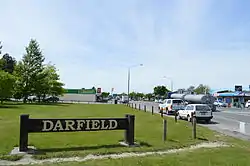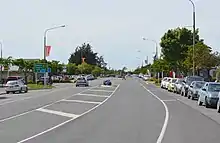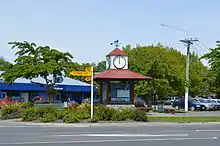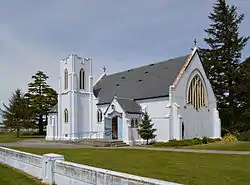Darfield, New Zealand
Darfield is a town in the Selwyn District of the South Island of New Zealand. It is 35 kilometres west of Christchurch. Its population is 3,150 as of June 2023.[3]
Darfield | |
|---|---|
 Darfield sign on New Zealand State Highway 73, the main street of Darfield | |
| Coordinates: 43°29′S 172°07′E | |
| Country | New Zealand |
| Region | Canterbury |
| Territorial authority | Selwyn District |
| Ward | Malvern |
| Community | Malvern |
| Electorates |
|
| Government | |
| • Territorial authority | Selwyn District Council |
| • Regional council | Environment Canterbury |
| • Mayor of Selwyn | Sam Broughton |
| • Selwyn MP | Nicola Grigg |
| • Te Tai Tonga MP | Tākuta Ferris |
| Area | |
| • Total | 15.14 km2 (5.85 sq mi) |
| Population (June 2023)[3] | |
| • Total | 3,150 |
| • Density | 210/km2 (540/sq mi) |
| Time zone | UTC+12 (NZST) |
| • Summer (DST) | UTC+13 (NZDT) |
| Postcode(s) | 7510 |
| Area code | 03 |
| Local iwi | Ngāi Tahu |
Darfield is the main town between Christchurch and the West Coast region. It is often called "The township under the nor'west arch" in reference to a characteristic weather phenomenon that often creates an arch of cloud in an otherwise clear sky to the west of the township. This is caused by the condensation of water particles channelled upwards over the Southern Alps.
Darfield lies in the Malvern district's arable and pastoral farming area. It is a gateway to the scenic Waimakariri and Rakaia rivers and the Southern Alps, and is also a popular lift-off place for hot air ballooning.
Darfield is located around the former junction of the railway lines coming from Christchurch and going to Whitecliffs (where coal was mined) and Springfield and on to the West Coast.
History
Darfield was first known as White Cliffs Junction, but was then renamed in 1879 to Horndon Junction. This name was changed again to avoid confusion with Hornby [railway] Junction (close by in Christchurch).
Darfield acquired its name from John Jebson who named it after the village in Yorkshire, England. The name refers to a field frequented by deer.[4]
A stone mill for grinding flour was built in 1887. It was powered by the Selwyn County Council's water race.
2000s–present
A magnitude 7.1 earthquake occurred near Darfield at 4:35 am on 4 September 2010, causing widespread damage to both the town and to surrounding areas including the city of Christchurch.[5]
Fonterra invested $500 million in a milk processing plant which was opened in 2013 in Darfield. This includes the world's largest dryer which is used in the process to make instant wholemilk powder.[6][7]
Climate
Located on the Canterbury Plains at an altitude of 193 metres (633 feet) above sea level, the Köppen-Geiger climate classification for Darfield is Cfb (Oceanic). On several days a year, Darfield is subject to the nor'west Foehn wind, which is very dry and has the capability to raise the temperature by several degrees per hour. On the contrary, the town is also susceptible to cold blasts from the Southern Ocean, especially during winter, when a southerly wind blows. The average annual temperature in Darfield is 11.6 °C (52.9 °F). The highest recorded temperature is 40.7 °C (105.3 °F), set on 8 February 1973, while the lowest recorded temperature is -8.0 °C (17.6 °F), set on 7 June 2012. The highest minimum temperature is 25.7 °C (78.3 °F), set on 6 February 2011, while the lowest maximum temperature is 0.6 °C (33.1 °F), set on 12 July 2017. On average, Darfield can expect to see 38.3 days of frost per year, and 49 days where the maximum temperature exceeds 26.7 °C (80 °F).
| Climate data for Darfield, 193 m | |||||||||||||
|---|---|---|---|---|---|---|---|---|---|---|---|---|---|
| Month | Jan | Feb | Mar | Apr | May | Jun | Jul | Aug | Sep | Oct | Nov | Dec | Year |
| Record high °C (°F) | 38.4 (101.1) |
40.7 (105.3) |
37.6 (99.7) |
31.4 (88.5) |
27.2 (81.0) |
22.3 (72.1) |
20.5 (68.9) |
23.3 (73.9) |
27.8 (82.0) |
30.0 (86.0) |
31.9 (89.4) |
36.5 (97.7) |
40.7 (105.3) |
| Average high °C (°F) | 23.0 (73.4) |
22.7 (72.9) |
20.6 (69.1) |
17.4 (63.3) |
14.4 (57.9) |
11.4 (52.5) |
10.9 (51.6) |
12.3 (54.1) |
14.8 (58.6) |
17.0 (62.6) |
19.1 (66.4) |
21.3 (70.3) |
17.1 (62.8) |
| Daily mean °C (°F) | 16.9 (62.4) |
16.5 (61.7) |
14.9 (58.8) |
12.0 (53.6) |
9.3 (48.7) |
6.6 (43.9) |
6.2 (43.2) |
7.3 (45.1) |
9.5 (49.1) |
11.4 (52.5) |
13.2 (55.8) |
15.4 (59.7) |
11.6 (52.9) |
| Average low °C (°F) | 10.8 (51.4) |
10.6 (51.1) |
9.4 (48.9) |
6.6 (43.9) |
4.3 (39.7) |
2.0 (35.6) |
1.6 (34.9) |
2.4 (36.3) |
4.2 (39.6) |
5.8 (42.4) |
7.4 (45.3) |
9.6 (49.3) |
6.2 (43.2) |
| Record low °C (°F) | 0.6 (33.1) |
1.6 (34.9) |
0.3 (32.5) |
−0.3 (31.5) |
−2.1 (28.2) |
−8.0 (17.6) |
−6.4 (20.5) |
−3.1 (26.4) |
−2.6 (27.3) |
−2.2 (28.0) |
−1.2 (29.8) |
0.2 (32.4) |
−8.0 (17.6) |
| Average rainfall mm (inches) | 60.3 (2.37) |
51.1 (2.01) |
60.5 (2.38) |
78.8 (3.10) |
58.1 (2.29) |
61.8 (2.43) |
59.4 (2.34) |
68.1 (2.68) |
46.7 (1.84) |
67.6 (2.66) |
54.6 (2.15) |
63.9 (2.52) |
730.9 (28.78) |
| Source 1: Climate-data.org[8] | |||||||||||||
| Source 2: weatherbase.com[9] | |||||||||||||
Demographics
Darfield is described by Statistics New Zealand as a small urban area, and covers 15.14 km2 (5.85 sq mi).[2] It had an estimated population of 3,150 as of June 2023,[3] with a population density of 208 people per km2.
| Year | Pop. | ±% p.a. |
|---|---|---|
| 2006 | 1,974 | — |
| 2013 | 2,397 | +2.81% |
| 2018 | 2,724 | +2.59% |
| Source: [10] | ||
Darfield had a population of 2,724 at the 2018 New Zealand census, an increase of 327 people (13.6%) since the 2013 census, and an increase of 750 people (38.0%) since the 2006 census. There were 1,053 households, comprising 1,338 males and 1,389 females, giving a sex ratio of 0.96 males per female. The median age was 43.9 years (compared with 37.4 years nationally), with 507 people (18.6%) aged under 15 years, 435 (16.0%) aged 15 to 29, 1,218 (44.7%) aged 30 to 64, and 564 (20.7%) aged 65 or older.
Ethnicities were 94.6% European/Pākehā, 6.6% Māori, 1.4% Pasifika, 2.0% Asian, and 3.1% other ethnicities. People may identify with more than one ethnicity.
The percentage of people born overseas was 16.3, compared with 27.1% nationally.
Although some people chose not to answer the census's question about religious affiliation, 52.5% had no religion, 38.3% were Christian, 0.2% were Hindu, 0.2% were Muslim, 0.1% were Buddhist and 1.1% had other religions.
Of those at least 15 years old, 348 (15.7%) people had a bachelor's or higher degree, and 462 (20.8%) people had no formal qualifications. The median income was $36,400, compared with $31,800 nationally. 450 people (20.3%) earned over $70,000 compared to 17.2% nationally. The employment status of those at least 15 was that 1,146 (51.7%) people were employed full-time, 324 (14.6%) were part-time, and 39 (1.8%) were unemployed.[10]
The population of Darfield was 830 people in 1971.[11]
Education
Darfield has numerous kindergartens. The original Darfield school was opened in 1883 with a total of 18 students attending. By 1902 the school had two teachers and ninety-three students children on the school roll.[12]
Darfield Primary School is Darfield's sole primary school, catering for years 1 to 6.[13] It has 244 students.
Darfield High School is Darfield's sole intermediate/highschool, catering for years 7 to 13.[14] It has 777 students. The school was established in 1951 as a secondary school, and expanded to cover intermediate students in 1978.[15]
Both schools are coeducational. Rolls are as of April 2023.[16]
Industry
Many industries are present in Darfield, including brick-making, seed cleaning, and a Fonterra factory, which processes milk powder. The factory has a series of railway sidings and a container loading centre.[17]
Services

Darfield has a shopping precinct along the main street, including a Four Square supermarket. The town also has many churches, most notably St Joseph's Catholic Church and Trinity Church (Anglican, Methodist, Presbyterian). Darfield has two resthomes.
Other services include: a bakery, bank, cafés and bars, hotels, a library, motels, numerous petrol stations, a post office, and a veterinary clinic.
Darfield is also has police, fire and ambulance stations, as well as a medical centre and a hospital.
Selwyn is not connected to a district wide sewage scheme. This necessitates all homes to have their own septic tanks.[7]
Recreation
Darfield has a domain, which includes duck ponds and the community centre. Football and rugby fields, tennis courts and a Scouts building are also located in the domain.
Westview Park is located in between the Midland railway line and State Highway 73 and to the west of Four Square Darfield. It boasts attractions such as the Whitecliffs Branch historical site and a skatepark.
McHughs Forest Park is located northwest of Darfield. It was planted in 1893 to provide timber for mid Canterbury. It contains a mix of Douglas Fir, Pinus Radiata, Macrocarpa, Larch, Spruce and other exotic species. There are a series of walking tracks within the forest.
Transport

Bus
Darfield is serviced with the 86 bus route, a morning and evening express route that connects the town with Central Christchurch, via Kirwee, West Melton and Yaldhurst.[18]
Rail
Darfield is served by the Midland railway line. The TranzAlpine train stops twice daily (request only); en route to the West Coast and on its return trip back to Christchurch.
Road
Darfield is served by State Highway 73 (Great Alpine Highway), connecting Christchurch with the West Coast region and State Highway 77, connecting Darfield with Ashburton via Methven, the Rakaia Gorge and Glentunnel.
Notable people
- Sir Allan Wright (29 March 1929), President of Federated Farmers and first chancellor of Lincoln University.
- Geoff Wright (29 March 1929), New Zealand cricketer
- John Wright (5 July 1954), New Zealand cricketer and former coach of the Indian national cricket team
- Henry Shipley (10 May 10 1996), New Zealand cricketer[19][20]
- Brian Connell (23 April 1956), politician
- Mary Clinton (8 May 1960), New Zealand field hockey player
- James Te Huna (29 September 1981), first New Zealander to enter the UFC, 2010 (Ultimate Fighting Championships)
Gallery
 St Joseph's Catholic Church, October 2013
St Joseph's Catholic Church, October 2013 Trinity Church, October 2013
Trinity Church, October 2013 Cafe in central Darfield, October 2013
Cafe in central Darfield, October 2013 Historic jail dating 1915, October 2013
Historic jail dating 1915, October 2013 Darfield War Memorial, located next to Trinity Church, October 2013
Darfield War Memorial, located next to Trinity Church, October 2013
References
- "Electorate Boundaries". Archived from the original on 8 February 2013. Retrieved 20 December 2016.
- "ArcGIS Web Application". statsnz.maps.arcgis.com. Retrieved 17 October 2021.
- "Subnational population estimates (RC, SA2), by age and sex, at 30 June 1996-2023 (2023 boundaries)". Statistics New Zealand. Retrieved 25 October 2023. (regional councils); "Subnational population estimates (TA, SA2), by age and sex, at 30 June 1996-2023 (2023 boundaries)". Statistics New Zealand. Retrieved 25 October 2023. (territorial authorities); "Subnational population estimates (urban rural), by age and sex, at 30 June 1996-2023 (2023 boundaries)". Statistics New Zealand. Retrieved 25 October 2023. (urban areas)
- "Darfield | NZHistory, New Zealand history online". nzhistory.govt.nz. Retrieved 27 November 2020.
- Booker, Jarrod (4 September 2010). ""Extremely violent" 7.4 quake hits Christchurch". The New Zealand Herald.
- "Fonterra sinking millions into South Island". Stuff. 14 November 2014. Retrieved 27 November 2020.
- "Small town life: Does Darfield need a gimmick to put itself on the map?". Stuff. 8 August 2015. Retrieved 27 November 2020.
- | "Climate-data.org – Climate Data for Cities Worldwide". openstreetmap.org. Retrieved 22 December 2020.
- /ref> "Weatherbase". CantyMedia. Retrieved 22 December 2020.
- "Statistical area 1 dataset for 2018 Census". Statistics New Zealand. March 2020. Darfield (334000). 2018 Census place summary: Darfield
- Taonga, New Zealand Ministry for Culture and Heritage Te Manatu. "Darfield district". teara.govt.nz. Retrieved 27 November 2020.
- "Darfield | NZETC". nzetc.victoria.ac.nz. Retrieved 27 November 2020.
- Education Counts: Darfield School
- Education Counts: Darfield High School
- "About Darfield High School". Darfield High School. Retrieved 17 October 2021.
- "New Zealand Schools Directory". New Zealand Ministry of Education. Retrieved 12 December 2022.
- "KiwiRail opens South Island Freight Link". International Railway Journal. 20 April 2013.
- "Darfield/City | Metro Christchurch". metroinfo.co.nz. Retrieved 21 September 2020.
- "Henry Shipley". archive.nzc.nz. Retrieved 22 December 2022.
- Egan, Brendon (19 December 2022). "'Genuine allrounders are like gold dust: Newest Black Cap Henry Shipley could fill a key need". Stuff. Retrieved 22 December 2022.
External links
- Darfield on the Selwyn District Council website Archived 29 January 2018 at the Wayback Machine